Mobile Ivy Bridge and ASUS N56VM Preview
by Jarred Walton on April 23, 2012 12:02 PM ESTBattery Life: Generally Improved, Depending on the Laptop
Another important metric for Ivy Bridge is battery life. We used our standard battery life test settings: 100 nits on the LCD, which was 25% in Windows’ power settings for the N56VM, and we use a tweaked Power Saver profile. We then timed how long the N56VM could last off the mains in idle, Internet, and H.264 playback scenarios, along with some “gaming” on the HD 4000. We’ll start with the charts.
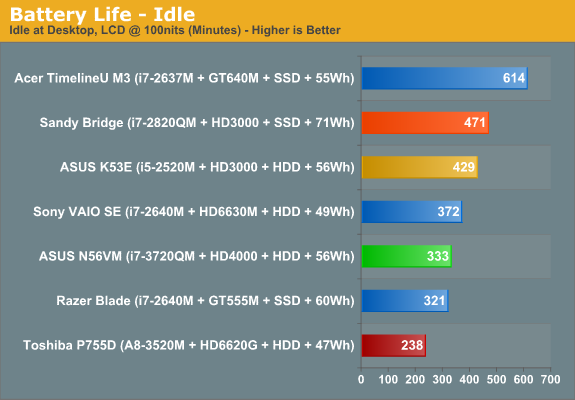
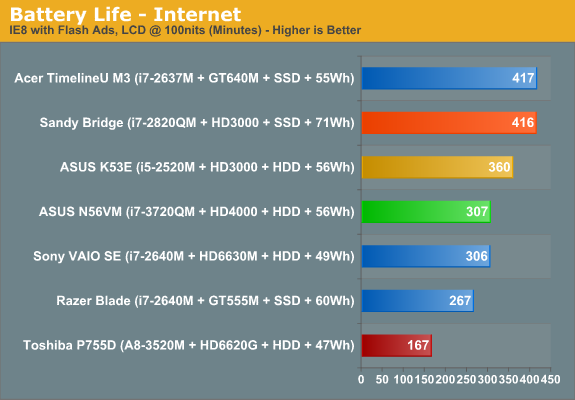
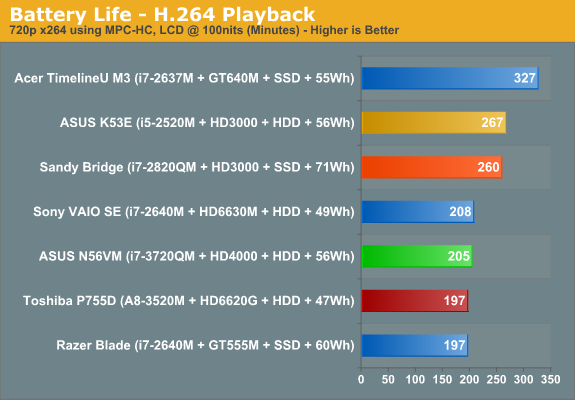
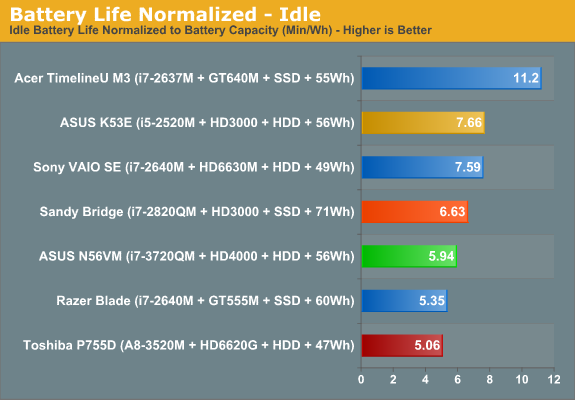

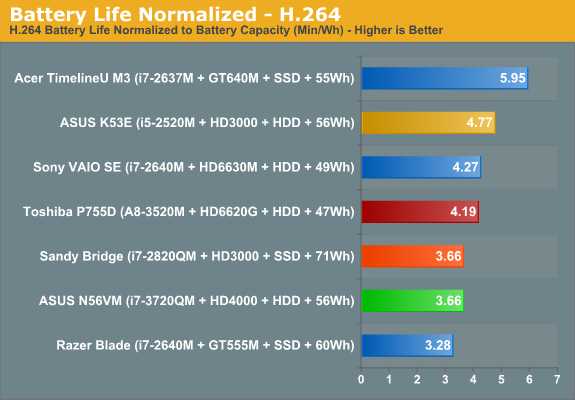
One thing that we need to point out is that the original Sandy Bridge i7-2820QM laptop from Intel was an awesome example of how to deliver great battery life. We never did reach that same level with any of the retail quad-core laptops that we tested over the past year, but then most of the other quad-core laptops also included some form of discrete graphics. Compared with that particular notebook (which never shipped as a retail product), our Ivy Bridge notebook has worse battery life. Once we start comparing with retail laptops however—particularly those with switchable graphics—Ivy Bridge ends up looking like it will deliver similar to slightly better battery life relative to Sandy Bridge.
With a 56Wh battery, the N56VM manages 5.5 hours of idle battery life, five hours of Internet battery life, and just under 3.5 hours of H.264 battery life. Normalize that to battery capacity and the N56VM beats most of the quad-core Optimus enabled laptops from the past year in our tests, but it frequently loses to the dual-core Sandy Bridge laptops. If we take the best scores for each normalized battery life test (Idle, Internet, and H.264), Dell’s XPS 15 leads the N56VM in the H.264 and Idle tests, the Alienware M14x has a better Idle result, and the CyberPower X6-9100 comes out slightly ahead in H.264 as well, but the N56VM is 10% ahead of the closest Sandy Bridge quad-core in the Internet results. It’s also worth noting that as a whole, the N56VM places near the top of the normalized results for quad-core CPUs. Of course there are plenty of other laptops that deliver better battery life—ultrabooks and netbooks in particular, along with many of the dual-core Sandy Bridge offerings—but they’re not anywhere near the same performance class as standard voltage Sandy/Ivy Bridge.
There’s more to battery life than the above charts might suggest, unfortunately. While we’d love to make a definitive statement with regards to Ivy Bridge battery life, the reality is that we’re looking at our first Ivy Bridge laptop and we really have no idea how it will compare with future Ivy Bridge implementations. What’s more, we’re dealing with pre-release hardware, so ASUS likely hasn’t had quite as much opportunity to optimize for battery life as what we’ll see on the retail units. Optimizing for battery life is a complex task, and we’ve seen some manufacturers succeed while others fall well short. For example, the difference between the best and worst normalized battery life for quad-core Sandy Bridge laptops (not counting the non-retail notebook) is around 50% across all three of our tests—so the worst laptop might get 2.6 min/Wh in our H.264 playback test while the best laptop scored 3.9 min/Wh. That’s a pretty big difference, and until we test a few more Ivy Bridge laptops we won’t really know what to expect.
Gaming on Battery
Some of you have requested battery life while gaming, and we also did a test where we looped 3DMark06 (just the four gaming tests) at 1366x768 until the battery gave out. Using the “Balanced” power profile with the HD 4000 also set to “Balanced” performance, the N56VM managed 79 minutes before shutting down. That might seem like a poor showing, until you realize that the ASUS K53E (dual-core Sandy Bridge i5-2520M) only lasted 73 minutes in the same test, all while delivering 35% lower graphics performance.
Another interesting item to report is that previously we suggested that Llano was the champion of our “gaming off the mains” test: the A8-3500M lasted a whopping 161 minutes looping 3DMark06 when we first tested it, but unfortunately that was with the GPU set to maximize battery life—which means less than half the normal GPU performance. With the A8-3500M set to maximum performance (which is how we’re testing the HD 4000), battery life in our 3DMark06 loop drops to just 98 minutes with a 58Wh battery. That’s still better than the HD 4000 battery life while delivering roughly the same level of graphics performance, though it’s also with a 14” LCD so we’re not comparing otherwise identical platforms. Finally, running the same 3DMark06 loop on the N56VM with the GT 630M active (and set to “Prefer Maximum Performance”) results in 67 minutes of battery life.
If we do some quick math, 3DMark06 uses around 41.7W with the HD 4000 active compared to 49.1W with the GT 630M. Llano meanwhile uses just 35.5W under the same load. For Ivy Bridge, the 7.4W difference under load is significant, but at the same time NVIDIA (and AMD) GPUs appear more efficient for the performance they provide. It’s difficult to say exactly how much of the power draw is going to the GPU versus the CPU and the rest of the system, but the GT 630M can consume up to 35W and is likely using somewhere around 20-25W in this test; that means for less than half the performance, the HD 4000 looks to be consuming around 13-18W. Even if those numbers are off, one thing is clear: Llano is still the chip to beat for gaming on battery power. It’s just unfortunate that the CPU side of Llano is so far behind, but hopefully Trinity will change things in the near future.










49 Comments
View All Comments
JarredWalton - Tuesday, May 1, 2012 - link
Ivy Bridge is technically capable of supporting three displays, but it needs three TMDS transceivers in the laptop (or on the desktop motherboard) to drive the displays simultaneously. Some laptop makers will likely save $0.25 or whatever by only including two, but others will certainly include the full triple head support.JarredWalton - Thursday, May 10, 2012 - link
Just a quick correction, in case anyone is wondering:For triple displays, Ivy Bridge needs to run TWO of the displays off of DisplayPort, and the other can be LVDS/VGA/HDMI/DVI. I can tell you exactly how many laptops I've seen with dual DP outputs: zero. Anyway, it's an OEM decision, and I'm skeptical we'll see 2xDP any time soon.
JarredWalton - Tuesday, April 24, 2012 - link
"I'm not sure what your point is, at all"? You cannot be serious. Either you have no understanding of thermodynamics, or you're just an anonymous Internet troll. I don't know what your problem is, rarson, but your comments on all the Ivy Bridge articles today are the same FUD with nothing to back it up.Ivy Bridge specifications allow for internal temperatures of up to 100C, just like most other Intel chips. At maximum load the chip in the N56VM hits 89C, but it's doing that with the fan hardly running at all and generating almost no noise compared to other laptops. Is that so hard to understand? A dual-core Sandy Bridge i7-2640M in the VAIO SE hits higher temperatures while generating more noise. I guess that means Sandy Bridge is a hot chip in your distorted world view? But that would be wrong as well. The reality is that the VAIO SE runs hot and loud because of the way Sony designed the laptop, and the N56VM runs hot and quiet because of the way ASUS designed the laptop.
The simple fact is Ivy Bridge in this laptop runs faster than Sandy Bridge in other laptops, even at higher temperatures than some laptops that we've seen. There was a conscious decision to let internal CPU temperatures get higher instead of running the fans faster and creating more noise. If the fan were generating 40dB of noise, I can guarantee that the chip temperature wouldn't be 89C under load. Again, this is simple thermodynamics. Is that so difficult to understand?
How do we determine what Ivy Bridge temperatures are like "in general"? How do you know that it's a "hot chip"? You don't, so you're just pulling stuff out of the air and making blanket statements that have no substance. It seems you either work for AMD and think you're doing them a favor with these comments (you're not), or you have a vendetta against Intel and you're hoping to make people in general think Ivy Bridge is bad just because you say so (it's not).
mtoma - Tuesday, April 24, 2012 - link
I really don't want to play dumb - but if I get an honest answer I'll be pleased: Jarred said that the panel used in Asus N56VM is an LG LP156WF1. OK - how can I find the display type in a specific laptop? I have a Lenovo T61 and... I need help. I want to know the manufacturer, display type, viewing angles. Thanks!JarredWalton - Tuesday, April 24, 2012 - link
I use Astra32 (www.astra32.com), a free utility that will usually report the monitor type. However, if the OEM chooses to overwrite the information in the LCD firmware, you'll get basically a meaningless code. You can also look at LaptopScreen.com and see if they have the information/screen you need (http://www.laptopscreen.com/English/model/IBM-Leno...leovande321 - Wednesday, May 15, 2013 - link
AUO 10.1 "SD + B101EVT03.2 1280X800 Matte Laptop Screen Grade A +I hope to help you!!!
AUO BOE CMO CPT IVO 10.1 14.0 15.6 LED CCFL whoalresell
Wholesale Laptop Screens www.globalresell.com
Spunjji - Thursday, April 26, 2012 - link
Calm down there. His comment is pointing out that measuring the temperatures of this laptop will tell you nothing about how hot mobile Ivy Bridge is as a platform. We need more information. It looks like it's not as cool as Intel marketing want everyone to believe, but we just don't know yet.JarredWalton - Thursday, April 26, 2012 - link
The real heart of the matter is that more performance (IVB) just got stuffed into less space. 22nm probably wasn't enough to dramatically reduce voltages and thus power, so the internal core temperatures are likely higher than SNB in many cases, even though maximum power draw may have gone down.For the desktop, that's more of a concern, especially if you want to overclock. For a laptop, as long as the laptop doesn't get noisy and runs stable, I have no problem with the tradeoff being made, and I suspect it's only a temporary issue. By the time ULV and dual-core IVB ship, 22nm will be a bit more mature and have a few more kinks ironed out.
leovande321 - Wednesday, May 15, 2013 - link
AUO 10.1 "SD + B101EVT03.2 1280X800 Matte Laptop Screen Grade A +I hope to help you!!!
AUO BOE CMO CPT IVO 10.1 14.0 15.6 LED CCFL whoalresell
Wholesale Laptop Screens www.globalresell.com
raghu78 - Wednesday, May 2, 2012 - link
Even though you have mentioned that 45w Llano would have improved the gaming performance it would have been better to include such a configuration in your testing. Given that you were testing a 45w high end next gen core i7 product which itself skews the balance in Intel's favour given the vast difference in CPU processing capability the least you could have done was put a similar wattage AMD Llano SKU. The result would be that other than Batman and Skyrim the rest would all be better on HD 6620G. As they say "a picture is worth a thousand words ". All your charts cannot be undone by a small note at the end of the charts. The damage has been done.This is my opinion that objective comparisons can only be made under similar parameters. Its even more critical in the notebook market which have strict thermal restrictions. The desktop market is slightly less restrictive except for HTPCs which need 65w or lesser processors. When the comparisons for Trinity 35w are made it should be against 35w Ivybridge core i3 and core i5. By benching a ivybridge core i7 with a 45w rating and comparing with a Trinity 35w we aren't making a fair and objective comparison. Also the fact that the ivybridge core i7 and trinity are not in the same price segment makes things worse. I hope my comments are not taken negatively.